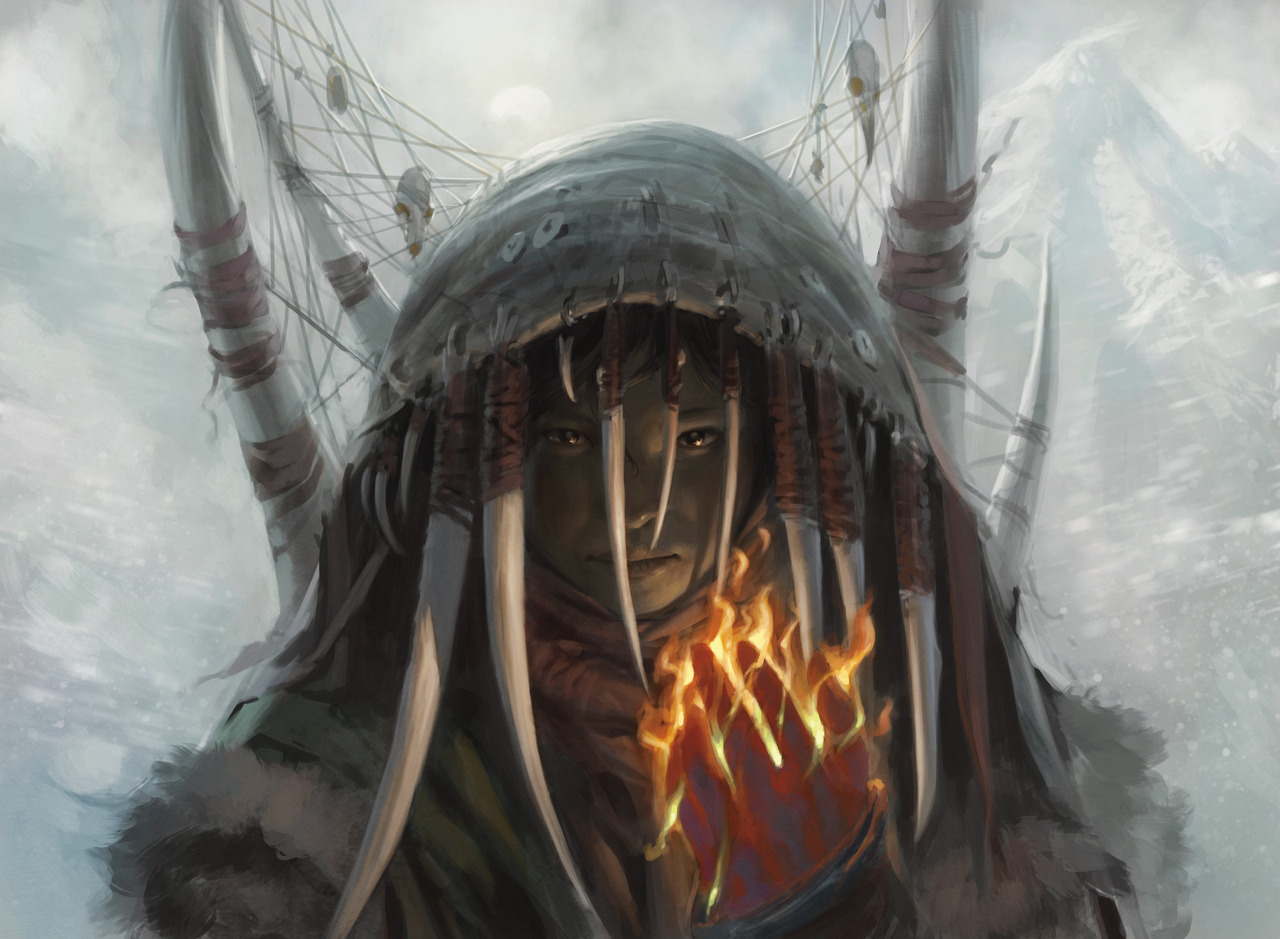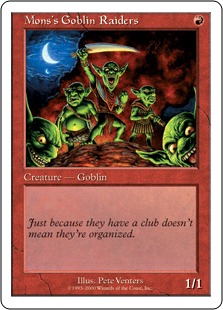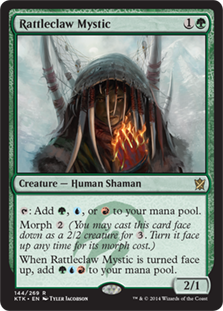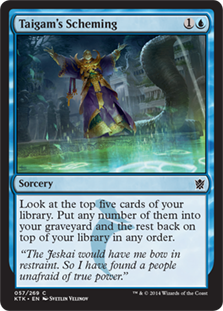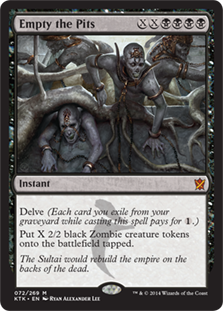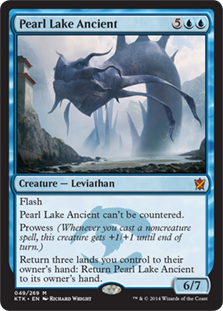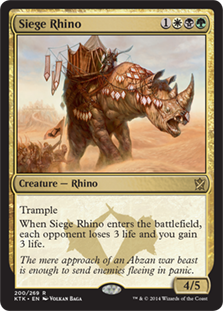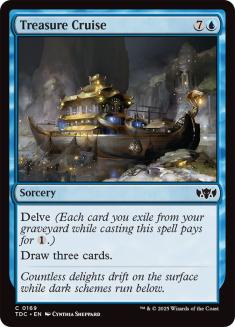Okay, then.
My first day in the office, Dave Humphreys pulled me into a meeting room and told me about Khans of Tarkir. He started with the key points to the set, eventually getting into the set mechanics. Afterward, I was given printouts of all the sets in their Future Future League (FFL), which included Theros, Born of the Gods, Journey into Nyx, Core Set 2014, and Khans of Tarkir, and told to get to work. I was ordered to only think in terms of Standard because Modern would require too much bandwidth and, with such a large card pool, could probably solve any issues that arise on its own.
In hindsight, I would have tackled this process much differently, but I started reading cards, getting some ideas, and putting decklists together. I wanted to see what the FFL had come up with and compare notes.
Except it didn’t really exist.
I failed the Wizards of the Coast (WotC) written test the first time I took it, and they hired Adam Prosak instead. After he had been there for a few months, they wanted another contractor, so they hired me. As it turns out, things were even worse when Adam first arrived, which was probably why Theros, devotion, and Nykthos, Shrine to Nyx were so messed up. Somehow, FFL just stopped being a thing, and it was Adam’s unspoken job to help revive it.
There wasn’t a dedicated team, and as folks picked up more responsibility, they didn’t have the bandwidth to build decks or play them, so it just kinda stopped happening. My hiring was another step toward restoring the FFL, so Adam and I did the vast majority of the Constructed playtesting.
First, we need to meet the cast.
Initially, my desk wasn’t in “the pit,” although it was close enough to hear bits of their conversations. In order to join those conversations, I would have had to yell, which isn’t exactly proper office etiquette. I was there, but not there, and it was one of the many small things that made it seem like they weren’t ready for another employee.
After a much-needed desk reorganization that made me actually feel like part of the team, Ian Duke sat across from me, with us facing each other. He was one of the people I wish spoke more often. I just wanted to turn him upside down and shake him until all of his thoughts came out.
Behind Ian were Erik Lauer and Mark Rosewater, who both talked quite a lot. I wasn’t mad about that fact, even if it did mean the occasional Erik pop quiz.
Erik: What do you think is the strongest two-mana creature ever printed?
People in the pit: I dunno? Tarmogoyf? Snapcaster Mage? Maybe it’s Dark Confidant.
Erik: I think it’s Narcomoeba!
Pit: [groans, realizing that Erik is probably right and they fell for his trick question again]
Later…
Erik: Who do you think the protagonist is in the film The Terminator?
Pit: Sarah Connor? Wait, is it John Connor?
Erik: See, that’s what most people think, but I think it’s The Terminator! The entire movie is about his mission to go back in time and kill John Connor. Then he dies at the end and it’s very sad that he didn’t get to complete his mission. Plus, the movie title is his name!
Pit: [groans]
Later…
Erik: What do you think is the strongest green creature ever printed?
Me: [shutting the hell up because I know this is a trick]
Pit: Tarmogoyf? Wait, no, Elvish Spirit Guide? Oh! Oh! Hermit Druid!
Erik: I think it’s Golgari Grave-Troll!
You get the idea.
Ben Hayes sat next to Erik. Sam Stoddard was on my right, while Tom LaPille and Dave Humpherys were behind me. Adam was kitty-corner from me, which was good, because he was the person I talked to the most. By the time I got there, Sam, Ben, and Tom had some set leads under their belt. I believe Ian had his first when I was there. When I left, Adam Prosak was doing his first lead on Tempest Remastered.
Mons Johnson is another character who might show up in the story. Even though he worked on Duel Masters, anyone in the office could access Multiverse, Drake, and the various tools WotC employees used. He would occasionally check in on Magic, find some wild interaction to build around, and bring it to our attention.
I remembered Mons because of Grand Prix Las Vegas 2002. There was a feature written about him that mentioned he was, in fact, the namesake of Mons’s Goblin Raiders and one of the initial Magic playtesters. The feature was memorable because Mons was the first person to take Goblins, a notoriously aggressive tribe, and build it differently. He included Goblin Recruiter and Goblin Ringleader as a draw engine, which is how the deck had been built for over a decade at this point.
It shouldn’t be any surprise that he was great at building around unique ideas. He was the first person to identify Jeskai Ascendancy and Sylvan Caryatid as a potential engine, although he didn’t end up producing an overwhelmingly powerful build. Honestly, we probably didn’t give his creations enough of a look. Part of that was because my powers were limited — I couldn’t look at a Mons combo deck and immediately know how to improve it. We lacked that capability overall, and it ended up being a massive blind spot.
When I started working on Kaijudo (effectively Duel Masters, but rebranded for the Western audience), Mons was who I reported to. Tom LaPille was my personnel manager (or something, I forgot the exact title; it was almost a decade ago), which basically just meant we’d have weekly check-in meetings. Erik Lauer was development manager, but Dave Humpherys handled the personnel relations, which meant I had monthly check-ins with him.
Aside from Erik and Ian, I had been in the trenches of the competitive scene with some amount of overlap with everyone else on the dev team. I played Dave at Worlds one year and used to see the Ohio guys (Tom, Sam, and Adam) at local PTQs all the time. Ben Hayes had been one of my best friends. There was a rapport already. As a result, working with them was incredibly smooth.
It was said that everyone at WotC had a superpower, and it’s what made you invaluable to the company. It was true. My co-workers impressed me daily, and I’m not easily impressed.
Before we get into it, I have another disclaimer. This was almost a decade ago. Given that time frame, I’m surprised I remember as much as I do, but some of this is stuff I think about regularly. There are lessons, regrets, and fond memories here that keep it on my mind. If I get anything wrong, I apologize, but it would likely be semantics or embellishment for story-telling purposes anyway.
In a way, everything started with Rattleclaw Mystic. When I got to WotC, Rattleclaw Mystic was Temur’s version of Noble Hierarch. It morphed for G, but didn’t have the mana-adding ability when it turned face up. Overall, not the most outlandish design, but something that could potentially cause problems. Elvish Mystic was legal, as were the green devotion cards, so that was the first deck I built. It was obvious.
I couldn’t believe how mediocre Born of the Gods and Journey into Nyx were, but it made my job easier. Rather than needing to familiarize myself with four brand-new sets, all I needed to know were a few cards plus what was actually in Khans. The set was still in development, so things could and would change. Even if something was forgettable, it didn’t mean it wouldn’t become relevant later.
Taking in a thousand new Magic cards and starting the deckbuilding process is about as amazingly fun as you’d expect it to be. Despite trying to prepare myself for the tests and trickery, I failed this one hard. Or, at least, I failed to recognize what I was being tested for. However, what happened ended up being hugely beneficial.
I didn’t build many, if any, three-color decks.
They hired a fresh professional player, known for deck-building and brewing, and he didn’t build around the key selling point of the new set. My colleagues must have thought they either grossly overestimated my abilities or that something was horribly, horribly wrong.
Honestly, it was probably a bit of both, but when I started being asked questions, it was becoming apparent that I had exposed a massive flaw in Khans Standard basically on Day 1.
As clever as I thought I was, I didn’t figure out what the test was exactly. I suppose I thought the test to get the job in the first place was the main hurdle. Now that I was in the building, I’d be able to just work. I was wrong. However, I might have done the same thing even in hindsight. If someone’s first thought when seeing Khans is, “Oh, those three-color cards look cool, but I’m going to build mono-green instead,” there’s a problem.
Even my Temur decks didn’t follow the prescribed formula for wedge decks. I played Mana Confluence instead of trilands and kept my Temple count to a minimum. At one mana, Rattleclaw Mystic was busted.
Erik had a plan for Khans Standard, which I didn’t find out until a few months later. He wanted the first set to highlight the wedge cards and decks, eventually weaken them over time, and then potentially introduce something to power them back up toward the end of their life cycle. It’s a cool plan, but how do you accomplish that?
The biggest part was limiting the amount of playable two-drops, which sounds weird. That would encourage folks to play manabases where the first two lands could enter the battlefield tapped, as they knew they were unlikely to be punished. After Khans, the sets would have a higher focus on introducing some playable, cheaper cards, which would eventually lead to folks playing fewer than three colors. Over time, three-color decks would become few and far between.
How I built decks exposed a flaw in that plan, which led to Rattleclaw Mystic becoming a two-drop. It was a necessary change, but a sad one. Each wedge had its own identity, and Temur’s hinged on Rattleclaw Mystic powering out big stuff. Mana advantage and cards like Crater’s Claws and Stubborn Denial gave it a nice tempo feel, which was severely hindered once Rattleclaw Mystic was two mana. Instead of feeling like the card that gave Temur its identity, Rattleclaw became yet another random card in the file that happened to tie to a clan.
Temur took several massive hits before FFL was concluded and Khans shipped out to the world, even if it suffered very few direct nerfs itself. If I could go back, I’d probably buff a Temur card or two. It was one of the better performers during FFL, other things got buffed as a result, and we didn’t really double back to ensure Temur still had legs.
Despite no longer being a Top 10 card in the set, Rattleclaw had some interesting decision points once it was two mana. Simply morphing for G wasn’t impressive enough, so it picked up the ability of adding mana when it was turned face-up.
Should Rattleclaw Mystic morph for colorless mana? Very few cards did that in the set, but Erik liked the idea that if you were manascrewed (which would presumably happen more often in Limited than Constructed), you could morph it and turn it face up to fix your issues. I agreed with that play pattern being a net positive, but suggested maybe the morph cost should be UR instead.
It meant you couldn’t get the mana trigger if you were only playing Gruul or mono-green, but it’s possible that the mana ability for morphing didn’t get added until later. Playing Rattleclaw Mystic as an off-color morph was very doable, and it made me sad that it wouldn’t automatically flow to the green player.
Either way, I’m happy with how the card turned out, even if it looks super-strange to me. That’s only because I was there internally and the real world didn’t seem to think it looked out of place or over-developed. Plus, it saw play! The mana ability was relevant. Everything worked out. Phew.
Despite being mostly a clown shoes mechanic, delve was interesting to develop, at least the first time.
Murderous Cut is cost-efficient, appealing, and didn’t have the potential to be broken. There were also other delve cards competing for the same resources, so the Dig Through Time control decks would often forego Murderous Cut entirely.
My rule for delve was that you can change the generic cost in the card and it will have very little effect. Casting the first copy generally isn’t difficult if your deck is maximized to do so. It can limit the first turn the delve spell is cast or how quickly they’re able to cast the second copy, but if all they want to do is cast one copy, adding a generic mana is a tiny bump in the road.
That rule stayed true for Empty the Pits. I tested XXXB and XXBB and both allowed me to make a lethal amount of Zombies on Turn 4. If I spent the first few turns setting up, I could even use a defensive spell on Turn 4.
The Empty the Pits combo deck was a masterpiece. It used Sign in Blood and Read the Bones to find the win condition and provide cardboard to fill the graveyard. Thoughtseize and Urborg, Tomb of Yawgmoth were important as well. Taigam’s Scheming initially looked at six cards, which helped find Empty the Pits while also fueling delve.
Once Empty the Pits became XXBBBB, the deck could no longer durdle until Turn 4. It had to interact because most decks could goldfish by Turn 5, especially when you’re punching yourself with Thoughtseize and Sign in Blood. It meant the deck needed a turn of breathing room. That meant it had to slow down by a turn or two. At that point, you were better off playing traditional Dimir Control.
Oh, what could have been had I not been in that room.
I played against so many damned Perilous Vaults (and later, Crux of Fates) that I wanted to tear my hair out. The most frustrating aspect was how many of my contemporaries wanted to play multiple games, even if they had no chance of generating new, useful data.
“Let’s play 40-minute games where I am effectively pre-sideboarded against you and you have eight dead cards” isn’t the most useful way to spend two people’s time.
I hate Prognostic Sphinx and Pearl Lake Ancient. We were coming off a period where Aetherling was the frustrating control win condition of choice, and they understandably wanted to tone that down. Prognostic Sphinx is already a glacially slow win condition, but it also has scry 3, which means your opponents spent another 30 seconds fiddling with their deck while you silently wished for a chandelier to fall and crush you both.
Admittedly, Pearl Lake Ancient itself wasn’t as large of an offender. The control decks usually stabilized with the opponent having a couple of useless Hero’s Downfalls in hand. They’d deploy Pearl Lake Ancient, you’d point a Downfall at it, they’d pick it up, and then you’d play draw-go for a couple of turns before doing the same song and dance. Eventually, you’d lose, but first you had to think that maybe you had a chance and wasted everyone’s time.
At least Aetherling killed quickly. Yes, it was frustrating because it came down a tad too early, but at least the game ended. Prognostic Sphinx and Pearl Lake Ancient could have been Millstone and they’d have won the game at the same pace. Ensuring that Pearl Lake Ancient kept prowess was the best part about the card. At least we didn’t have Ancients staring at each other.
We played the occasional tournament where we got to use sideboards, and I don’t remember control ever doing particularly well.
Good.
Here we go.
I figured out what Temur was capable of early on. Adam worked on various Jeskai decks, which was fine with me, and his versions all had legs. Sultai seemed like it was going to be a Whip of Erebos / Sidisi, Brood Tyrant deck, which was also cool. Mardu and Abzan were the two outliers. Butcher of the Horde changed abilities a couple of times and mostly ended up as a reasonably aggressive wedge that could utilize tokens and sacrifice effects. It was weak, which made it niche, but something had to be the worst.
Abzan always had Sylvan Caryatid and Courser of Kruphix to fall back on. Its spot removal options were good and Elspeth, Sun’s Champion was a powerful finisher. The details could change, but Abzan arguably had the strongest base to work with.
Adam’s initial claim to fame was getting Liliana of the Veil removed from Core Set 2014, which shouldn’t have been as much of a struggle as it was. There was probably a lesson in there about how they didn’t really trust the new guy. I didn’t pick up on it.
Initially, Siege Rhino was three mana and Anafenza, the Foremost was four mana. After Ccreative pointed out that it wouldn’t make sense for Anafenza to be a 4/6 lore-wise, their mana costs shifted and abilities were readjusted. When Khans was initially being designed, Liliana of the Veil was still in the file, so it was a Loxodon Smiter clone that also drained for two life. With Liliana gone, did we need the Smiter discard text, or should it be something else?
Everyone seemed to like the drain effect, and now Siege Rhino could be even bigger! They settled on a 1WBG 4/5 that drained for three and couldn’t be countered. After a few games against a control deck where they couldn’t do a damn thing about getting drained out of the game, we revisited the “can’t be countered” clause. Several cards already had the uncounterable clause in the set anyway.
At the time, token decks were performing well in FFL, so a few cards changed as a result. Temur Charm picked up a Falter ability, and Siege Rhino gained trample instead. Time was running out, there were other things that needed attention, and we didn’t play much Abzan after that. In my defense, I noted that drain three was very generous, but it fell on deaf ears. They weren’t gonna listen to the new guy without some proof.
Had I been able to test Abzan more, I probably would have noticed the battlefield stalls created by Siege Rhinos staring at each other. Even though it seems like a buff, I might have recommended that Siege Rhino be a 5/4, just to eliminate those stalls. That would open the door for Siege Rhino to be removed by Stoke the Flames, which partly led to Siege Rhino’s dominance. The card was punishing enough for red decks as it was, and dodging Stoke the Flames was unnecessary. At 5/4, the argument for drain two instead of drain three likely would have held more water. I’d be very interested to see how Standard would have been affected as a result.
Heading into the final stretch of set development is a wild ride. Our focus was on Limited, but things could have been different had Constructed not already been in a solid place. Despite there being some outstanding issues, we felt like they could be handled well enough in the time we had.
Limited typically concluded with an “off-site” event. WotC would rent out a hotel boardroom or some such and there would be drafting. All. Day. Long. The cast rotated, mostly to get as many eyes on what was close to a final product. Some folks, like me, participated in all the drafts and helped collect data.
How often did certain color pairs (or triads) show up? How many cards of each color got played? And how many multi-colored cards got played? Those questions tended to inform how balanced the colors were and how appealing the cards were.
Blue ended up being one of the least-represented colors, mostly because it felt like a supporting color. At 8U, Treasure Cruise routinely went tenth-pick or later. Erik chose that card to buff in order to help even things out.
We played Dig Through Time over Treasure Cruise in our FFL decks because it was cheaper. Once they were both in alignment, there needed to be a serious discussion about which was stronger in Standard. As it was, both broke Modern and people kinda hated us.
And yet, I apologize for nothing.
We had our orders and I followed them. In hindsight, I’d probably do things differently; still, all I could do was learn from the stuff that wasn’t ideal and ensure it wouldn’t happen again. Unfortunately, I left (or was forced out, depending on how you look at it) before any of that would matter.
This isn’t the end of my tale. Numerous cards in Khans have stories attached to them, plus there’s Fate Reforged! I hope this was entertaining and a fitting end to my career at Star City Games. My life was dramatically changed for the better because of SCG giving me a chance to write, then again by starting the SCG Tour, and again by giving me a reason to move to Roanoke. I’ll be forever grateful for that and for those who have enjoyed my content over the years.

